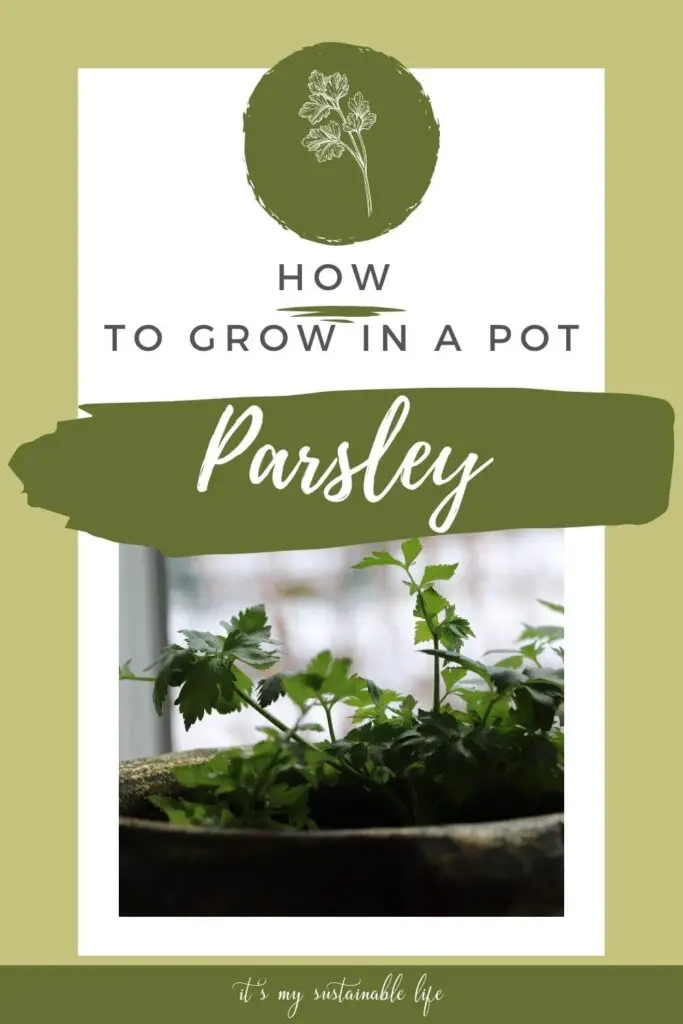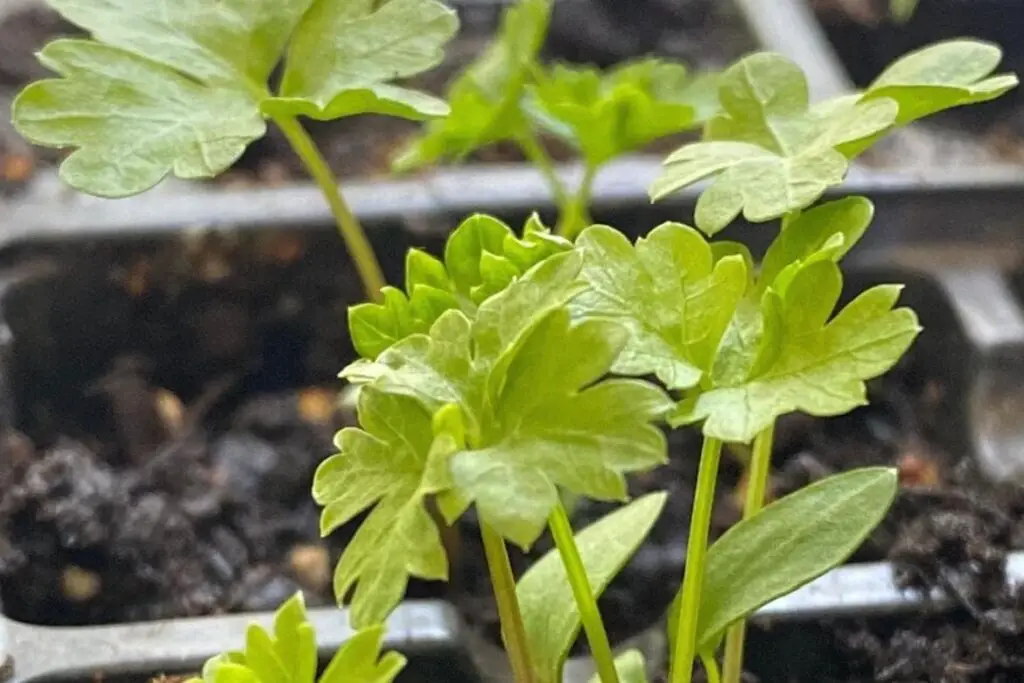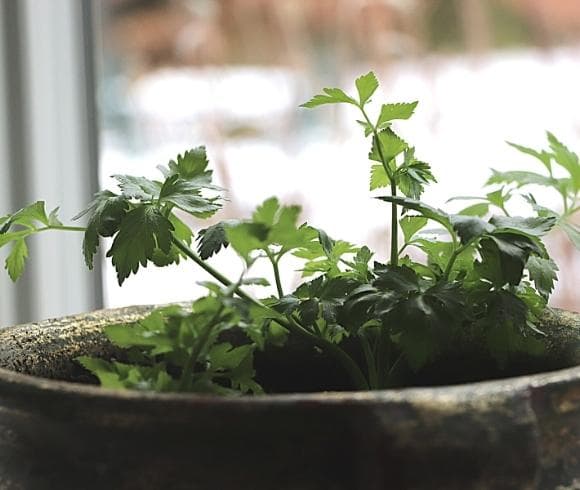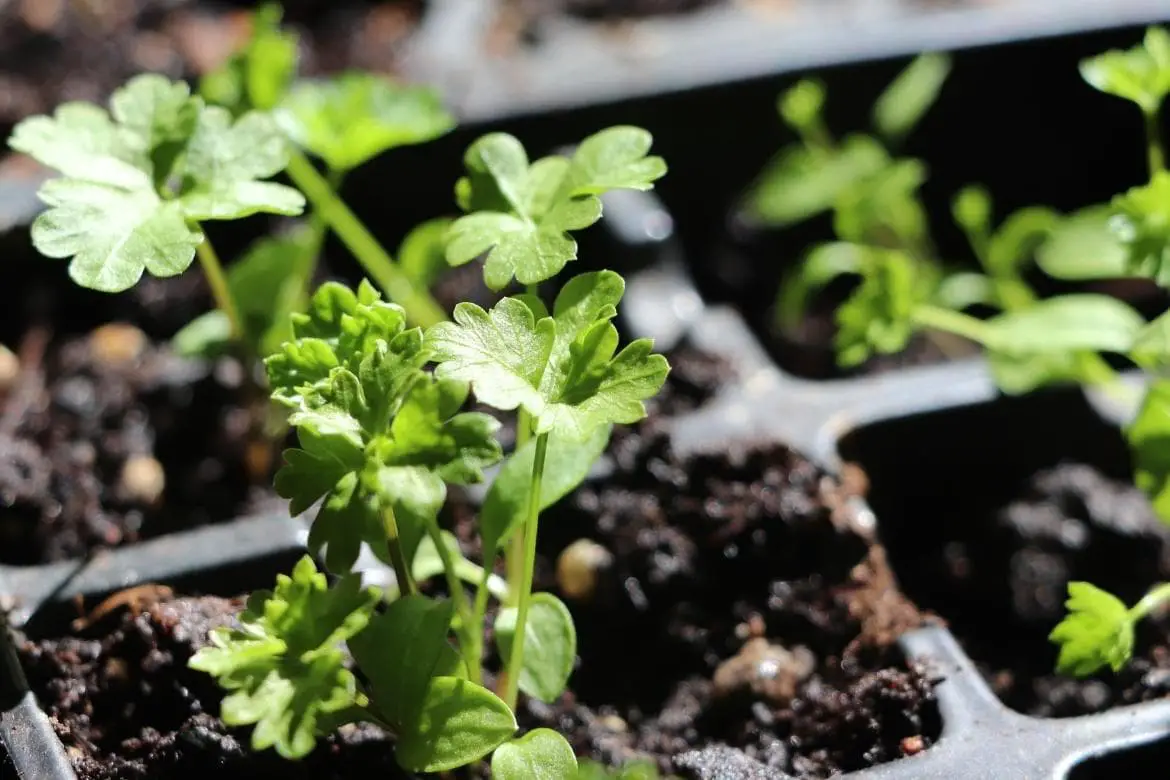Learn how to grow parsley in a pot. Growing parsley in containers is made easy with this ultimate guide!
This post may contain affiliate links at no additional cost to you. By making your purchases through the links on this website, IMSL may make a small percentage at no direct cost to you. IMSL only promotes products we use & truly believe in. Please refer to my Privacy & Disclosures for further information. IMSL thanks you for your support!
Learning how to grow parsley in a pot or container is an easy and straight-forward process. Not only is this compact herb a tasty addition to many culinary dishes, but is also a wonderful addition to ornamental displays.
Parsley’s benefits don’t stop at just adding flavor to our home cooked meals, however. Chock full of nutritive value, parsley also offers additional health benefits!
Oh, the love/hate relationship with parsley. You either love it or hate it.
Here on the hill , we love it. And not just as a garnish! Fortunately for us, parsley is easy to grow not only in pots and containers, but in our garden beds as well. It can also be easily grown hydroponically, but that is a topic for another discussion 😊
Read on and see just how easy it is to grow parsley in a pot, which parsley varieties are best to grow, how to care for your potted parsley, how to harvest parsley, and how to preserve parsley for use all year long!
DOES PARSLEY GROW WELL IN POTS?
In a nutshell….yes! Parsley does amazingly well when grown in pots either for ornamental purposes or culinary ones. Or both 😊
Parsley may be one of the easiest herbs to grow as long as its simple needs are met; lots of bright, direct light and plenty of water.
HOW MUCH WATER DOES PARSLEY IN POTS NEED?
Parsley, especially when grown in pots, requires ample watering. Luckily, this is one plant that will tell you when it’s thirsty. It will wilt or droop when it needs a good watering, recovering and perking up quickly once it gets what it’s asking for!
That being said, parsley does not like its root system to remain in water as it can encourage root rot. Offering your potted parsley plants good drainage is highly recommended. Make sure the pot you choose to grow your parsley in has drainage holes and the pot itself is lifted either with pot holders or some other apparatus so it’s not resting on directly on any surface area helps accomplish this.
I recommend checking your potted parsley often, especially in hotter climates as pots tend to dry out quickly. Parsley needs approximately 1 to 2 inches of water each week for optimal growth.
Those living in hot & dry climates may want to add a bit of mulch to aid in water retention. Remember, when mulching anything, be sure to leave a few inches between the mulch and the base of the plant to avoid disease or rot.
HOW MUCH SUN DOES PARSLEY IN POTS NEED?
As with almost all herbs, parsley, whether growing in pots & containers or in your garden bed, requires a lot of direct sunlight. Six to eight hours to be exact in a cool to moderately warm climate. For those in hot climates, plan on offering a bit of shade and respite from the intense heat during the afternoon hours.
No matter whether you are growing your parsley in pots indoors or out, should your pot or container not receive at least that amount of direct sunlight, plan on supplementing it with fluorescent lighting or grow lights.

PARSLEY FACTS, BENEFITS, AND USES
Parsley, aka garden parsley, is an herbaceous herb, Petroselinum crispum, native to the Mediterranean region from the family Apiaceae. The leaves of the parsley plant are used commonly in cooking throughout the globe. However, the seeds are also utilized in cooking, offering even stronger flavor than that of the leaves.
Parsley is bright green in color, and contains apiol, a compound within the essential oil of the plant.
Apiol, aka “liquid apiol” or “green oil of parsley”, is the extracted “oleoresin” (the semi-solid extracts) from the plant and is considered an irritant when taken in high doses.
Parsley leaves and stems are not the only edible part of the plant! Parsley’s root system is edible as well, often having the most robust flavor of all parts of the plant!
IS PARSLEY AN ANNUAL OR A BIENNIAL PLANT?
It really depends on your climate as to whether parsley is considered an annual (germination to seed production in one year and then dies), or a biennial plant (taking two years to complete its lifecycle).
In our colder climate, gardening zone 5b, parsley is considered an annual. Thus, growing parsley in a pot allows us to grow parsley continually throughout the year by bringing the planted pots in during the colder winter months. This is a wonderful option for seed savers, allowing the parsley plant to continue growing through its second year.
When mulched heavily, parsley can possibly over-winter and be revived come spring in order for the plant to produce seeds for those looking to save them. Beware, however, that the leaves will likely become bitter and tough, making it inedible in our humble opinion.
SHARING IS CARING ❤️

WILDLIFE ATTRACTED TO PARSLEY
There are several types of wildlife that parsley may attract in the garden. Swallowtail butterflies often utilize parsley as a host plant for their larvae. These typically show up as black and green striped caterpillars with yellow dots. They take advantage of the parsley plant for about a 2 week period before beginning their transformation.
Parsley is also attractive to pollinators, including bees when in flower. Once the flowers have developed their seeds, birds like the goldfinch will enjoy a feast.
IS PARSLEY A FAST GROWER?
Nope. Parsley’s germination is legendary for its slow germination rates due to its seed coat & furanocoumarins (organic chemical compounds) found within the plant. I’ve had parsley that has taken upwards of 6 weeks to germinate, although it can germinate anywhere between the 4-6 week mark! I have found that by soaking the tiny parsley seeds overnight helps speed up the germination period a bit.
Parsley is also a naturally slow grower all around. Period. So patience & planning is key when growing parsley, especially when growing from seed!
You can propagate parsley like other herbs from cuttings by simply cutting a 4-5 inch long stem, making sure you have several green leaves remaining at the top of the stem. Dip the end of the stem in a root stimulator and plant the stem an inch deep in soil. Keep the cutting in indirect light for a few weeks. By that time you should note root growth.
I would not recommend propagating parsley in water. Their tender stems would likely result in decay and ultimately slime.
DISCLAIMER
Recommendations and or suggestions made by this blog regarding husbandry and or herbal remedies etc. are not meant to replace solid advice from qualified professionals. None of the information on this blog has been evaluated by the FDA. Products or remedies mentioned are not intended to diagnose, treat, cure or prevent disease. Please do your due diligence. Research, talk to qualified professionals and proceed at your own risk.
NUTRITIVE BENEFITS OF PARSLEY
Parsley offers not just unique flavor, store-bought has nothing on home-grown parsley by the way, but is also full of nutritive benefits.
Full of vitamins and minerals, parsley even offers a small amount of protein and some surprising health benefits!
HEALTH BENEFITS OF PARSLEY
A good source of flavonoids (assist in regulating cellular activity in the body and fight off free radicals), antioxidants (luteolin, apigenin, folate, vit K, vit C, and vit A), parsley offers more than just a green garnish on the side of your meal!
AIDS WITH INFLAMMATION
Inflammation, especially when chronic, is the root cause of many common diseases. And studies are now recognizing this.
“An increasing body of evidence shows that chronic inflammation causes and advances many common diseases.”
NCBI
Fortunately, there are many foods that combat inflammation before it becomes a chronic issue, like turmeric and parsley.
How does parsley aid in the fight against inflammation in the body? Antioxidants. And full of them, including all those listed above, parsley aids in soothing out inflammation. Thus reducing risk of arthritic issues in the joints as well as the risk of many chronic diseases such as Alzheimer’s and Parkinson’s disease*.
IMPROVES BONE HEALTH
When your body is low in vitamin K the higher the risk of bone issues including fracture and the like.
Parsley’s vitamin K content can help reduce that risk. Just 10 springs of parsley offer enough vitamin K to reach the daily recommended intake!
FRESHENS BREATH
Similar to that of mint, parsley has long been utilized to freshen your breath when eaten after consuming a meal.
Parsley boasts of a compound, chlorophyll, which aids in combating harmful bacteria that can lead to bad breath. So chew a few sprigs and enjoy a healthier smile!
BEST VARIETIES OF PARSLEY TO GROW
When it comes to the varieties of parsley to grow, there are several cultivar’s of choice. Should you be growing parsley to enjoy its roots, a cultivar known as Hamburg is a favorite. For the purposes of this article, the focus will remain largely on leaf parsley options.
CURLY PARSLEY
In year’s past, any fine restaurant would offer a side garnish of this thickly curled parsley. Although it can be used for cooking and flavor, it pales in comparison to the flat leafed varieties in my opinion.
Curly leafed parsley does, however, make for amazingly textured ornamental flower window boxes, pots, and beds, in part due to its compact growth.

FLAT LEAF (ITALIAN) PARSLEY
Should you be looking for intense flavor in your kitchen dishes, stick with the flat leaf parsley varieties. Its flavor is stronger, more vibrant & sweeter than most other varieties of parsley.
This variety can get leggy when growing in a pot, thus not my first choice for hangers and beds. It is, however, much more heat tolerant than other varieties of parsley.
GROWING PARSLEY IN A POT CONSIDERATIONS
When growing parsley in a pot you have a few options of plant sourcing; either grow your own parsley from seed or purchase seedling plants already started for you from a local farm or nursery.
As with most plants, it all starts with a seed. Parsley seed are very small in size and remember, take a long time to germinate and grow. Should you decide to start your plants from seed, plant early to get a jump start and be ensured of hearty plants when it comes time to placing them outdoors!
The beauty of growing your parsley in a pot is its versatility. A great option for those with space limitations, parsley grows well in small area’s, porches, balconies, and windowsills alike. It’s also movable. Taking those pots indoors as well as out allows extended growing periods for this herb!
Taking into consideration a few points and deciding which suits best is the first step in growing some for yourself.
SOURCING PARSLEY SEED
Although there are a plethora of seed companies available, I have a few that are my go-to, trusted seed sources. After all, all seed is not created equal. For a complete look at seed differences be sure to take a look at this in-depth article.
As always, I highly encourage you to stick with organically grown seed, good for both you and the environment!
A few of my favorite seed sources are:
You really cannot go wrong with any of the above listed. That being said, I’ve had amazing germination success with all of the seed stock I’ve purchased from True Leaf Market!
CHOOSING YOUR POT TO GROW PARSLEY IN
Fortunately, parsley is not that picky about what kind of pot you choose to grow your parsley in. Be sure to check out these unique seed starting pots here if you will be growing parsley from seed!
That being said, should you live in an arid climate with hot temps, stay away from clay & terracotta pots. These type of pots will wick moisture from your plants and parsley prefers to stay moist. If you decide to go with either of these pots, be sure it is glazed on the inside of the pot to help retain moisture levels.
It is important to note though when choosing a pot that its big enough to meet your thirsty parley watering demands!
At a minimum the pot of choice should be at least 8 to 12 inches wide and 6 to 8 inches deep if you are planting directly into the pot with the intension of growing the parsley as an annual. Should your intent be to grow as a biennial, increase the size of the pot by 2-3 inches all around to support the larger growth.
You can start your parsley in seed starting cells and then carefully transplant once your parsley has developed its true leaves. However, for ease and ensuring the parsley plant remains firmly rooted and happy, planting directly into your pot of choice is recommended.
BEST POTTING SOIL FOR GROWING PARSLEY
Parsley enjoys well-draining soil that is rich in organic matter or when fertilized on a regular basis. Soil that has a pH range of 6.0 to 7.0 is best.
Pre-bagged commercial potting soil which is appropriate for both herbs and vegetables will ensure your plants receive all it needs to get growing!
CHOOSING THE LOCATION FOR GROWING PARSLEY IN A POT
As stated, parsley enjoys direct sunlight (6-8 hours) in cooler climates and an offering of shade during the afternoon hours in hot climates.
Again, the beauty of growing parsley in a pot is its mobility. It can easily be moved and adjusted to a different area’s should you need.
Parsley plants grow best when grown in temperatures ranging from 45°F to 61°F or 7°C to 16°C.
HOW TO GROW PARSLEY IN A POT FROM SEED
Now that you’ve chosen your seed, pot, soil, and location, planting your parsley from seed is the easy part 😊
- Determine the planting date by counting 6 – 8 weeks prior to your last expected frost date (if you don’t know yours, check yours HERE)
- Prepare the pot or planting cells, making sure they have suitable drainage holes. Sterilize them, add your moistened potting medium
- Sow the parsley seeds 1 to 2 inches apart 1/4 inch deep. Remember soaking your seed overnight is an option
- Place the planted parsley pot in the brightest location possible or preferably under fluorescent grow lights until germinated
- Water and keep moist but not soggy
- Plan on thinning should you get too many seedlings by snipping the seedling close to soil level with garden snips so as not to disturb the surrounding roots once the tender plants have developed the first true leaves
If you started your parsley in starter cells, plan on transplanting once the seedlings have developed a good root system into the pot of your choice using the guidelines as listed below.
Be sure to be as careful and not disturb the tender root system during this process as much as possible.
Typical potting soil can be used at this time, and using the guidelines as listed for sun/location, and watering.
Should you want to move your potted parsley outdoors once the threat of frost has passed, plan on hardening off the plants BEFORE moving them. The hardening process will allow your plants to slowly become accustomed to the outdoor elements; sun, heat, wind, and rain.
HOW TO HARDEN OFF PARSLEY GROWN IN A POT
Hardening off any plant is not difficult. It’s just a matter of timing. Hardening off parsley that’s been grown in a pot is no different than that of a tomato plant.
“simply place your tomatoes outside in a protected shaded area for a few hours. Bring them in. Gradually increase the time and sun exposure daily, bringing them in at night. Continue this process for at least 7-10 days, after which, they can be considered “hardened” and ready to plant directly into the garden.”
IMSL
HOW TO GROW PARSLEY IN A POT FROM SEEDLINGS
Don’t have the time or the wherewithal to grow your parsley in a pot from seed? Purchased seedling plants to the rescue! Organic parsley seedling plants are easily sourced from your local grower, farmer, garden center, or nursery.
GUIDE TO PURCHASING PARSLEY SEEDLINGS
When purchasing your parsley as seedling plants, keep a watchful eye on the following…
- Young – look for plants that are young, tender, and deeply green
- Healthy – avoid plants that are showing signs of wilting, yellowing, or flowering
- Soil – make sure the soil the seedling is planted in is not showing any signs of age. It should be black, moist, with no molding or hardening areas on the top
You will most likely need to transplant your parsley seedlings into your pot of choice as most purchased plants are ready for some space.
When transplanting your seedling plants go with at least an 8 to 10 inch pot. Fill your pot with potting soil and add in for good measure a bit of aged compost or manure. Gently remove the seedling from the growing cell and place into a pre-dug hole in your pot, place the seedling roots into the hole and backfill the soil gently, firming the rootball down.
Alternatively, before you place the seedling into your pot, soak the entire seedling in brown water (liquid fertilizer that has been diluted with water) and then proceed to transplant. Your parsley seedling will thank you for it 😊
Should you be placing the seedling into a garden bed, follow the same guidelines as above, spacing the plants at least 9 inches apart (the same rule of thumb for spacing works in pots as well) and watering in well.
Remember, parsley likes sun to part sun conditions for at least 6-8 hours a day with cool to warm temperatures. It will tolerate more shade in very hot climates. Parsley likes to stay moist and not dry out completely.

PARSLEY COMPANION PLANTS
When growing parsley in a pot or garden they enjoy a bit of company! Companion plantings if you will. Not only will they look more attractive, but they will often grow better next to other plantings.
A few companion plants to consider when growing parsley are…
- Tomatoes
- Onions
- Chives
- Corn
- Peppers
- Peas
- Roses
Stay away from planting parsley near lettuce or mint.
When growing parsley in a pot with other herbs and flowers, parsley makes for a wonderful textured display.
HOW TO HARVEST PARSLEY GROWN IN A POT
How you harvest parsley grown in a pot or garden really depends on the age of the plant itself. Remember at its core, parsley is a biennial plant (taking two full years to complete its lifecycle).
During the first years growth period plan on harvesting the leaves once the plant has grown to about 6 inches in height or at a minimum has produced at least 3 leaves on the stem. This should be about 2 to 3 months after your initial planting, or until the stems are divided into 3 sections.
To harvest the annual parsley plant simply pull from the outer stalks or branches first, leaving the center area to continue to grow. Cut the entire stalk or branch close to the ground and use at will.
And not just the leaves! Utilize the entire stem as well as they are even more potent and full of flavor than the leaves!
Avoid topping or pulling leaves just from the top of the stems as this will inhibit new growth.
It’s not recommended to harvest more than 1/3 at a time as this will stress the plant. Obviously, if you are done growing the plant harvest away! Some great preserving methods are discussed below.
The second year even though you can use the leaves & stems still (I find them to be tough and not as full of flavor at this point) it’s most likely the flowering you are after so seed can be gathered. The bee’s will love you for letting your parsley go to flower 🐝
If it’s the parsley root (very flavorful) you are after (parsley grows a taproot very similar to parsnip & dill), hopefully you’ve grown a variety such as Hamburg known for its root for this purpose. Simply dig it up during the fall of its second year growth, clean well and enjoy in salads and such!
PRESERVING & DRYING PARSLEY
Unless you are over-wintering indoors in colder climates, preserving the parsley harvest is a wonderful way to enjoy the flavors throughout the winter months.
There are many ways to preserve parsley and I have list 13 unique ways to do just that in my preserving fresh herbs article!
My most favorite way, however, to enjoy parsley anytime without having a living plant on hand is to dry them. Drying parsley is no different than drying my fresh basil at the end of each growing season. A complete tutorial can be found HERE.
My preferred method of drying is to simply cut the stems near the soil line, tie in bundles, and hang upside down in a well ventilated area until fully dry.
The oven method, using low 100°F to 110°F temps until dry, is another option. Just be sure to be vigilant and keep a close eye so as not to burn the tender shoots and leaves.
Whichever drying method you use, be sure to store your completely dried parsley in a closed container in a dark cool cabinet.

HOW TO CARE FOR POTTED PARSLEY
Maintaining & caring for your potted parsley no matter if its grown indoors or out, has the same requirements and needs.
FERTILIZING POTTED PARSLEY
Hopefully you’ve added a bit of aged compost or manure to the pot when transplanting.
Every other week to every month I like to feed my potted parsley with liquid kelp. I’ve used no other fertilizer for my plants that work better than this.
Containing trace elements and minerals, liquid kelp promotes amazing healthy, all around growth.
PRUNING & DEADHEADING PARSLEY
As with most plants, parsley, although requiring little care, takes well to a bit of pruning & deadheading.
To do so, simply remove any wilting, yellowing, or faded stems by snipping them close to the soil level. Doing so will not only encourage new foliage growth, but will tidy up your plantings and keep the plant shape.
Unless you want to gather and save parsley seeds, remove any flowering stalks that may appear (especially during the first years growth) to encourage flavor retention in the leaves.
PARSLEY DISEASES & PESTS
Parsley, like most herbs, has a few diseases to keep a watchful eye out for, but is generally an easy plant to grow…
- Alternaria leaf blight – caused from a fungus, this disease will show as black/brown lesions on the leaves that’s spread through infected seed source
- Cercospora leaf blight – also from a fungus which is spread through infected seed as well as wind or water splash, this disease shows itself on the leaves, eventually curling and dying off
- Damping off – seeds will rot & not germinate or the seedling will die almost immediately upon emergence
- Powdery mildew – powdery growth on leaves caused by a fungus
- Rust – discoloration of leaves and lesions appear causing stunted & distorted plant growth
Although not an exhaustive list, these are just a few disease issues which can appear.
In addition, keep an eye out for a few pests that enjoy feeding on parsley…
- Aphids – Is there any plant that these small white, soft bodied insects don’t enjoy 😅 Infestation can cause discoloration of leaves and stems and ultimately death of the plant. Spraying with a soapy/water mix works, especially when treated prior to a heavy infestation
- Army worm – Should you notice a few holes in the foliage, be on the lookout for for whitish or fuzzy looking eggs on them. It could be an indication of army worm infestation
- Cutworm – You know you have cutworms present should you find stems completely severed off near the soil line
- Root knot nematode – a reduction in plant vigor or yellowing which results in wilting in hot weather can be an indication of this nematode
Of all of the disease & pest issues listed, leaf blight/spots and rot may be the most common. Avoiding these issues is fairly simple. Avoid overwatering and resting water in the plant, and practice good husbandry overall.
Growing parsley in a pot is a wonderful option for those with only space limitations. Not only does it add unique flavor to meals, it also adds visual interest especially when planted amongst other herbs and plants.
Will you be growing parsley in a pot this year?
Love, Light, & Laughter ~

SHOP THIS ARTICLE
Enjoy this article? Please consider sharing it on your favorite social media channel! Want more? Subscribe below for the occasional update with all the “happenings on the hill”!



15 comments
I do love parsley for it’s health benefits and culinary uses! I’ve grown it both ways…in the garden and in pots that I carry indoors for the winter.
We love fresh parsley! This is definitely something I think I can do.
Great info and lots of details! I’ve never thought about doing this before, but it would be easy to follow your tips!
Great information. I don’t know why I never thought of raising pots for drainage.
I love the idea of starting small plants in eeds in pots and watching them grow!
I had no clue it was a biennial plant! This whole time I thought I’d randomly kill them and had no clue why 😅
I definitely do not have a love relationship with parsley haha. But I like the benefits to butterflies, pollinators and birds as a reason to plant it! With very limited gardening space I fully utilize using pots to plant the majority of my herbs and vegetables! Great post, full of great information!
I knew parsley was an antioxidant, but I didn’t realize it assists in regulating cellular activity in the body and fighting off free radicals. Thanks for the health information. I will remember to add it to my potatoes more often because it’s so good for you.
I have a baker’s rack that I’ve tried growing all my herbs in pots on and I think the issue I had with growing them (including parsley) in a pot was how fast they dried out. And as you’ve said, it needs ample water. I may try again with that in mind. With the warm So Cal summers, we’ll see how it goes.
Planting Parsley in a pot is a great idea to get it started.
This was a very informative post. I am going to try to start a small kitchen garden. Thanks for these very detailed tips. Loved this blog. Thanks.
Thank you, Sabrina! I’m excited for you to begin your kitchen garden!
Great info! Now I’m motivated to try it!
I decided this was my year to expand from just backyard vegetables to adding a full blown herb garden. Thanks for the tips with parsley!
Thank you for reading, Susan! I’m happy you enjoyed the suggestions!